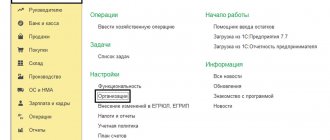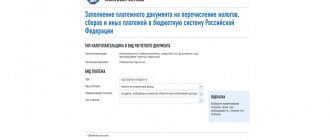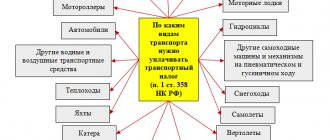In this article we consider the issues of filling out and submitting a zero UTII declaration for the 3rd quarter of 2021. Let us remind you that each obligatory payment provided for by the Tax Code has its own taxable base, which is reflected in the declaration. What if there is no base for a particular tax? Then you need to submit a “zero” declaration, or not submit it at all, if, in the absence of a base, the businessman (IP) is not a payer of this tax. But there is a third, special option. It is associated with reporting on the single tax on imputed income (UTII). Let's consider how and in what cases you should fill out a zero UTII declaration for 9 months of 2021 (or rather, for the 3rd quarter, because the tax period for UTII is quarterly).
Features of UTII and zero reporting
UTII is charged on the imputed amount, i.e. predetermined income, without taking into account actual revenue and generally regardless of the conduct of business. The main thing is that the taxpayer, in principle, has the opportunity to conduct business. What is necessary for this is determined by Art. 346.29 Tax Code of the Russian Federation. It lists the so-called “physical indicators” for different types of activities. This could be the number of staff, number of vehicles, retail space, etc.
If a businessman stops or suspends his activities, then, according to officials, he should be deregistered as a UTII payer. Article 346.28 of the Tax Code of the Russian Federation establishes a five-day period for this. If the taxpayer has not submitted such an application, then he must pay UTII based on the physical indicators reflected in the last submitted declaration. This opinion of the regulatory authorities is given in the letter of the Ministry of Finance dated October 24, 2014 No. N 03-11-09/53916.
However, there is a position of the Supreme Arbitration Court that differs from the approach of the Ministry of Finance (clause 9 of the Information Letter of the Supreme Arbitration Court of the Russian Federation No. 157 dated 03/05/2013). According to the judges of the Supreme Arbitration Court, there may be situations when a taxpayer, for objective reasons, is not able to use his assets to generate income:
- The vehicle has been leased to others or is being repaired after an accident.
- Part of the retail space is being renovated.
The letter from YOU refers to situations where an entrepreneur does not use only part of his assets, but continues to work. However, the same approach can be applied to a situation where a “force majeure” situation leads to a complete suspension of activities (for example, if the car involved in the accident was the only one).
The Federal Tax Service of the Russian Federation agreed with the position of the Supreme Arbitration Court in its information posted on the agency’s website on September 19, 2016.
However, the issue remains controversial. It is difficult to predict which explanation will be followed by local tax authorities in each specific case. In order to be guaranteed to avoid claims from tax authorities, in such a situation it is still better to temporarily deregister under UTII, and then (for example, after completion of repairs) re-apply for registration on it.
Next, we will consider how to fill out a zero declaration for those who nevertheless decided to use the explanations of the Supreme Arbitration Court and the Federal Tax Service of the Russian Federation.
Lack of activity by the “imputed” person is not a reason to submit a zero declaration
If the “imputed” person has ceased to conduct business, he needs to write an application to the tax office about deregistration as a UTII payer.
Look for forms in the article “Deregistration of UTII: conditions and terms.”
Without such an application, he will have to submit a UTII declaration, completed and with the tax calculated for payment. Since the taxpayer still has physical indicators, this is considered the basis for calculating imputed income and, accordingly, tax.
Filing a zero UTII declaration in this situation is illegal. This is the unanimous position of officials and judges (see letters of the Ministry of Finance dated July 2, 2012 No. 03-11-11/196, dated February 10, 2012 No. 03-11-06/3/8, resolution of the Federal Antimonopoly Service of the Far Eastern District dated December 23, 2013 No. F03- 6469/2013, left in force by the Determination of the Supreme Arbitration Court of the Russian Federation dated February 26, 2014 No. VAS-1903/14).
How not to pay UTII if your business is stopped due to coronavirus, find out in the material from ConsultantPlus. If you do not already have access to this legal system, a full access trial is available for free.
Old or new?
First of all, you need to decide on the form of the report. Today there is a new form of declaration, approved by order of the Federal Tax Service of the Russian Federation dated June 26, 2018 No. ММВ-7-3 / However, this document has not yet been registered with the Ministry of Justice.
Therefore, the tax authorities, in their letter No. SD-4-3/ dated July 25, 2018, reserve taxpayers the right to submit a UTII return for the 3rd quarter of 2021, both in the new form and “in the old way,” i.e. in accordance with the order of the Federal Tax Service of the Russian Federation dated July 4, 2014 No. MMV-7-3/
The essence of the changes to the form is to reflect the application of the new tax deduction. From the beginning of 2021, taxpayers - individual entrepreneurs have the right to reduce the amount of UTII payable on their expenses for the purchase of cash register equipment (clause 2.2 of Article 346.32 of the Tax Code of the Russian Federation).
It would seem that if the declaration is “zero”, then the “cash” deduction will still not be needed, and then what is the point of submitting it using the new form? However, we are talking about a situation where a businessman has temporarily suspended his activities, but intends to carry them on in the future. This means that he will be required to submit reports in the following periods. Therefore, it is advisable to immediately submit a new form, because in the future you will still have to use it.
Therefore, let’s look at the procedure for filling out a “zero” report using the new form as an example, noting its differences from the old one.
A sample of filling out a zero UTII declaration for the 3rd quarter of 2018 can be downloaded here .
There are no physical indicators: is it possible to submit a zero declaration?
If the UTII payer does not conduct business due to the loss of physical indicators (for example, when carrying out retail trade, he terminates the lease agreement for his retail space), when submitting the declaration, one must be guided by the explanations of the regulatory authorities. And they are ambiguous.
Thus, the Ministry of Finance insists that the filing of zero declarations on UTII is not provided for by the legislation of the Russian Federation. In his opinion, the “imputed person” must submit to the tax authorities a declaration with the amount of tax calculated for payment, even in the absence of physical indicators (letters dated 04/15/2014 No. 03-11-09/17087, dated 07/03/2012 No. 03-11-06/ 3/43).
In this case, the Ministry of Finance, in letter No. 03-11-09/53916 dated October 24, 2014 (hereinafter referred to as letter No. 03-11-09/53916), proposes to fill out a declaration based on the indicators specified in the last UTII declaration submitted to the tax authorities. This letter also provides an example of the procedure for filling out the declaration. So, if it is impossible to indicate in the declaration a physical indicator for the first month of the quarter (the lease agreement for the retail space was terminated), this indicator must be taken from the last submitted declaration. In the next months of the quarter, when the lease agreement has already been concluded, the indicators are reflected on the basis of the new agreement. Thus, physical indicators must be indicated in the UTII tax return for each month of the quarter.
The Federal Tax Service indicates the following: if the ownership or use of property necessary for this activity is terminated, then there are no physical indicators for calculating UTII. In this case, the amount of UTII payable for the corresponding tax period will be 0 rubles (see Information dated September 19, 2016).
You can learn about the calculation of physical indicators in retail trade from the material “How to calculate the area of a sales floor for the purposes of applying UTII?”.
Title page
This section includes general information about the taxpayer and the return itself. Its format and filling procedure have not changed compared to the previous report.
- TIN and checkpoint codes are taken from the certificate issued by the Federal Tax Service. For an entrepreneur, the checkpoint is not completed.
- The adjustment number is indicated in the form “0 – -”, “1 – -” and shows whether changes were made to the report.
- The period for submitting the report is reflected in the fields “Reporting year” (2018) and “Tax period”. The tax period code is taken from Appendix No. 1 to the Procedure for filling out, attached to the letter dated July 25, 2018 No. SD-4-3/ (hereinafter referred to as the Procedure ). For the 3rd quarter, the code “23” is used.
- The Federal Tax Service code, like the Taxpayer Identification Number, is filled out on the basis of the certificate.
- The code for the place of delivery is taken from Appendix 3 to the Procedure. It shows on what basis the report is submitted to this Federal Tax Service (this may be place of residence, registration, business, etc.).
- The code of the reorganization form (from Appendix 2 to the Procedure) and the codes of the reorganized company are filled in only by the legal entity - the legal successor, submitting a report for the reorganized company.
- The contact phone number is indicated without spaces or other “additional” characters.
- The number of sheets of the report itself and supporting documents (if any).
- Confirmation of the accuracy of the report. This block includes the full name, signature of the responsible person and the date of completion. If the report is submitted by a representative, then information about him and the details of the power of attorney are indicated.
- Data on the acceptance of the report is filled out by the tax inspector. They include the filing form, number of sheets, registration number, date, full name and signature of the Federal Tax Service employee.
The procedure for terminating activities on UTII
From all of the above, it is clear that if an entrepreneur decides to cease operations, then this must be formalized. You can't just stop reporting. This will lead to penalties from inspection authorities.
If you decide to no longer conduct activities that fall under the UTII taxation regime, then, according to Art. 346.28 of the Tax Code of the Russian Federation, you must submit an application to the Federal Tax Service. Do this within five days from the date of termination of business activities that fall under this tax regime. The application form was approved by Order of the Federal Tax Service dated December 11, 2012 No. ММВ-7-6/ [email protected]
Legal documents
- By Order of the Federal Tax Service dated July 4, 2014 No. ММВ-7-3/ [email protected]
- Art. 346.32 Tax Code of the Russian Federation
- Article 119 of the Tax Code of the Russian Federation
- Art. 76 Tax Code of the Russian Federation
- Article 346.28 of the Tax Code of the Russian Federation
- Information letter of the Presidium of the Supreme Arbitration Court of the Russian Federation dated 03/05/2013 No. 157
- Letter dated April 15, 2014 No. 03-11-09/17087
- Art. 346.29 Tax Code of the Russian Federation
- Determination of the Constitutional Court of the Russian Federation dated June 23, 2015 N 1538-O
- By Order of the Federal Tax Service dated December 11, 2012 No. ММВ-7-6/ [email protected]
Section 1: zero tax payable
This part of the form also “passed over” from the old declaration without changes. It includes information about the amounts of UTII payable to the budget. The section structure includes a number of blocks of lines 010 and 020.
Line 010 reflects the OKTMO code at the place of activity or place of registration.
Line 020 contains the amount of tax payable under this OKTMO code. In this case, it indicates zero.
The indicators of section 1 must be certified by the signature of the responsible person.
Zero declaration for individual entrepreneurs on OSNO
Zero reporting is evidence of a businessman’s lack of entrepreneurial activity. As in the case of UTII, a zero OSNO declaration for individual entrepreneurs is not submitted. But, if during the reporting quarter there was no movement of finances, there was no economic activity, then a simplified (zero) declaration for individual entrepreneurs is submitted to the tax government agency. A sample form can be downloaded from our website.
The deadlines for this reporting are as follows:
- April 20 - first quarter;
- July 20 - half term;
- October 20 - three quarters;
- January 20th is one year.
Sample of filling out a simplified declaration (download) Simplified declaration form (download) The reporting indicates the taxes that a businessman must pay in the order in which they are located in the Tax Code.
Section 2: tax and activities
It calculates the amount of tax for each OKTMO or type of activity. It also has not changed compared to the previous declaration form.
- Line 010 contains the activity code. It is selected from Appendix 5 to the Order. For example, for the provision of motor transport services for the transportation of goods, code 05 is indicated.
- Lines 020 and 030 include the address of the activity and the corresponding OKTMO code.
- Line 040 reflects the basic profitability by type of activity (Article 346.29 of the Tax Code of the Russian Federation). For road freight transportation this is 6,000 rubles. for 1 car per month.
- Lines 050 and 060 contain correction factors. Coefficient K1 is a deflator common to all “imputers”. For 2018, it was approved in the amount of 1,868 (Order of the Ministry of Economic Development dated October 30, 2017 No. 579). The K2 coefficient is determined at the local level and takes into account the peculiarities of conducting a specific type of activity in a given region.
- Lines 070 – 090 contain the calculation of the tax base by month, namely:
– Column 2 reflects the size of the physical indicator, i.e. in this case – zero;
– column 4 indicates the tax base, taking into account coefficients K1 and K2, i.e. similarly – zeros are filled in;
– column 3 is used if the businessman was deregistered or registered during the period; in this case, dashes are placed in it.
- Line 100 reflects the tax base for the quarter, i.e. the sum of lines 070-090 in column 4, respectively, also contains a zero indicator.
- Line 105 shows the tax rate in %.
- Line 110 contains the total amount of accrued tax for this OKTMO (type of activity), i.e. in this case - zero.
UTII: general provisions
An individual entrepreneur and a legal entity whose activities are described in Art. 346.26 Tax Code of the Russian Federation. For example, an economic entity that operates in the field of public catering, personal services, road transportation, provides housing for rent, provides service station services, etc. can become a UTII payer. In addition to the types of activities, the UTII payer must fulfill a number of other conditions (limitation on the number of employees, participation in the authorized capital of other organizations). Registration of UTII is carried out according to an application, which the payer must send 5 working days before the start of the reporting year. If all conditions are met, then the organization/individual entrepreneur becomes the “imputeur” from January 1.
The tax that must be paid to the “imputed” person is calculated based on the following indicators:
- Basic profitability (the amount is fixed by law and varies depending on the type of activity);
- Physical indicator (number of employees, store/cafe area in square meters, number of passenger seats in a minibus, etc.);
- Coefficients K-1 (in 2021 it is 1,798 for all types of activities in all regions) and K-2 (set by the local municipality depending on the conditions for conducting activities in the region);
- Tax rate (basic 15%, preferential 7.5%).
The amount of tax payable for the year is determined as the product of all the above indicators:
N = Profitability * Physical Indicator * Coefficient-1 * Coefficient-2 * Rate
Section 3: Zero Tax Calculation
This part of the report calculates the total tax amount for all OKTMO and types of activities, taking into account deductions. In section 3, line 040 was added in the new form, reflecting the “cash” deduction.
- Line 005 indicates the taxpayer's characteristics. Attribute “1” is assigned if the “imputer” makes payments to individuals. If the taxpayer is an entrepreneur without employees, then characteristic “2” corresponds to him.
- Line 010 reflects the total amount of accrued UTII from all sections 2, i.e. in our case - zero.
- Lines 020 and 030 contain the amounts of insurance premiums and other payments paid for employees and for themselves (for individual entrepreneurs), which reduce the amount of UTII payable. If such payments were made during the period, then they can be indicated in these lines for reference.
- Line 040 reflects the amount of deduction for the purchase of cash registers. It is unlikely that a businessman who has suspended work will buy a new cash register, so in this case we indicate zero.
- Line 050 contains the amount of tax payable, taking into account deductions. Even if lines 020 – 040 contain non-zero indicators, line 050 still needs to be set to zero - the value in it cannot be negative (clause 6, clause 6.1 of the Procedure).
Cases when zero tax is allowed
Commercial activities do not always comply with strict tax laws. Often, the reasonable approach and logic of the Federal Tax Service, the Ministry of Finance and judges allow the imputed person to reduce tax obligations.
One of these cases is associated with the presence or absence of a physical indicator:
Often you have to defend your right to zero UTII in court, but the likelihood of a successful outcome is high.
See what this looks like in practice.
The imputed person conducted business using a rented retail space. The lease agreement was suddenly terminated by the landlord. However, the Federal Tax Service Inspectorate accrued additional UTII for the reporting quarter - the entrepreneur went to court to invalidate the inspectorate’s decision.
The court sided with the IP. The argument worked: it is impossible to charge tax based on a physical indicator that does not exist (Resolution of the Administrative District of the East Siberian District dated March 16, 2017 No. A33-224/2016).
To win in court, you should have documented evidence of the absence of a physical indicator and termination of activity.
Section 4: deduction by cash register
This section is completely new and was introduced to “decipher” the deduction for cash registers. Each block of lines 010-050 contains information about one cash register:
- Name.
- Factory number.
- Registration number with the Federal Tax Service.
- Registration date.
- Purchase costs (within the established limit of 18,000 rubles per unit of cash register).
In our case, dashes are placed in all lines of the section.
Regulations for submitting reports and sanctions for violation
The procedure for submitting a declaration does not depend on whether it is “zero” or not. Clause 3 of Art. 346.32 of the Tax Code of the Russian Federation establishes that the UTII report must be submitted no later than the 20th day after the end of the tax period. Because 10/20/2018 is a Saturday, then taking into account the rules for postponing deadlines, the UTII declaration for the 3rd quarter of 2021 must be submitted no later than 10/22/2018.
But the fine for violating the deadlines for submitting a “zero” report is applied in a special manner. The point is that Art. 119 of the Tax Code of the Russian Federation connects the amount of the fine with the period of delay and the amount of tax payable specified in the declaration. Because in the “zero” report there is no amount to be paid “by definition”, then for any delay the same minimum fine is applied - 1000 rubles.
Also, additional sanctions may be applied for violating the deadlines for filing a declaration.
Firstly, this is an administrative fine in the amount of 300 to 500 rubles, imposed on responsible persons under Article 15.5 of the Code of Administrative Offenses
Also, the tax authority, if there is a delay of more than 10 days, has the right to block the taxpayer’s accounts (clause 3 of Article 76 of the Tax Code of the Russian Federation). And in this case, the fact that the report is “zero” does not matter.
What are the risks of filing a zero UTII return to the tax authorities?
Based on the inconsistency of the above explanations, as well as established judicial practice, filing a zero UTII return is fraught with claims from the tax authorities.
Inspectors, following the explanations from letter No. 03-11-09/53916, will most likely charge additional tax based on the physical indicators given in the last submitted UTII declaration. In addition, they will charge penalties for late payment of taxes and may impose fines.
If the taxpayer’s physical indicators are preserved, then according to the information letter of the Presidium of the Supreme Arbitration Court of the Russian Federation dated March 5, 2013 No. 157, the court decision will definitely be in favor of the tax authorities. In the absence of physical indicators, you can try to challenge the additional assessed tax amounts, but there is no guarantee that the court will side with the taxpayer. As examples of disputes won by taxpayers, let us cite, perhaps, the resolution of the Arbitration Court of the West Siberian District dated August 17, 2016 No. F04-3635/2016 and resolution 12 AAS dated November 21, 2014 3 A12-15103/2014.






